2015-06-27
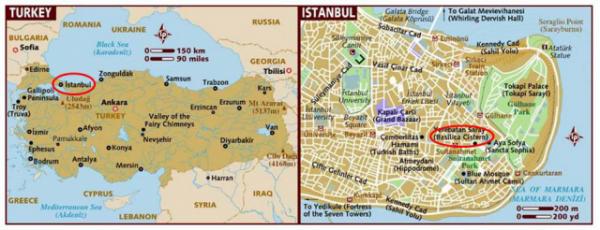
【Aiden in English】
Water meant life at the start of the universe. Everyone needs water; unfortunately, dehydration can be fatal. Approximately 1,500 years ago, the Byzantine Empire sought a water source to quench its thirst during a time of siege. The underground cistern was established. It not only provided a water filtration system for the Great Palace of Constantinople and other buildings on the First Hill but continued to serve the Topkapi Palace after the Ottomans conquered in 1453 and into modern times. When examining the Ottoman Empire during the Medieval Ages, you'll see an empire that stretched from central Europe to Asia Minor, Egypt, and Nubia, covering approximately 9,000 square miles or 23,000 square kilometers. And as a conquering army took control over the land, the people of other mighty armies had to choose sides. One reason the Ottoman Empire became so… successful was that, most of the time, the empire didn't even fight to take over land. If you were an army rising in strength, your reputation would grow, and some enemies would get intimidated. So, the Ottomans gave the enemy leaders a choice to fight or join the empire, send soldiers, and pay taxes. Its strategy was good for any weaker rulers with little or no experience. This procedure sent the already fast car into overdrive. However, the fall of the Ottoman Empire was becoming increasingly possible, considering that powerful forces were interested in it. The palace of the Byzantine Empire in the capital of Constantinople demanded all the security it could get, and many stories usually sounded exaggerated. Just say that powerful kings fell to poison in their drinks. Water had to be checked to see if it was pure, and the stupid idea was born from the movies of a water checker who tasted all the liquids before giving them to the king. The solution was much more local. However, a simple water container wouldn't be of any use. They decided to make a reservoir. The people who lived in the palace required a poison detector. The answer was simple. Fish and the very ones ate the algae in the water. If the poison were detected, they would, ah, die in the king's place. The fish also kept the water clean. With all the crazy stuff built at the time, it's no wonder another fantastic architectural feat would be constructed. And indeed, there was. An underground cistern consisting of 12 enormous reservoirs was created with freshwater 140 feet (43 meters) below the surface. They were used frequently during the Ottoman Empire. Nevertheless, what saved the people on many occasions also seemed a bit spooky. The place wasn't precisely illuminated. The only light source was some dimly lit bulbs. The entire cistern was constructed with a forest of 336 pillars, suspending the roof, much like a Greek temple. But in truth, it looked quite the opposite. A couple of pillars with the head of Medusa in Greek mythology were flipped upside-down, symbolizing the defeat of the old empires, and now, a new king was taking over the town. The eerie lighting cast creepy shadows that flickered across her face. Whether the people went overboard or not, this cistern ensured the palace's safety with a reliable water supply. It’s a miracle that the empire even fell since they were so careful of everything and almost too thorough. Basilica Cistern, indeed, has more to say. 【红霞译】
水是宇宙的源泉,有水才有生命,人离不开水,遗憾的是,缺水问题一直存在,以前时有发生,今后也难以避免。大约一千五百年前,拜占庭“东罗马”帝国被困,大敌当前又急需水源解渴,于是地下蓄水池应运而生,它不仅为坐落于第一山丘显赫一时的君士坦丁堡王府提供了过滤水系统,而且在1453年奥斯曼“强大”夺取政权之后继续为托普卡帕“炮门”皇宫效力,并一直沿用到今。
回首中世纪奥斯曼帝国统治时期,你不难发现其疆域从欧洲到小亚细亚、埃及乃至努比亚,横亘9,000平方英里/14,484平方公里,武力入侵之后,被占领土所在民众都会顺应形势,当时奥斯曼帝国之所以势如破竹,无非在于被吞并的国家放弃抵抗。假如你的军队实力如日中天,其声誉也将名扬四方,敌对一方早已被吓得魂破,奥斯曼统治者趁机发号施令,敌对首领要么作战到底,要么放下武器带兵倒戈投诚并上缴苛捐杂税,这种战略战术对不堪一击或毫无经验的弱国相当奏效,从而大大加快了军阀称霸天下的进度,不过奥斯曼帝国越是猖獗越有可能招来其它强大力量争夺地盘,最终导致灭亡。
作为帝国首都的君士坦丁堡,拜占庭皇宫用水需求理应得到安全保障,由此杜撰出许多离谱的故事,比方说万能的君主喝水中毒。水质必须受到检查,电影上曾有过诸如此类的滑稽镜头,事先先由检验官试喝任何饮料,然后才能呈给帝王将相们享用。因此就近解决饮水问题迫在眉睫,但简单的贮水容器再大也不够用,修建水库无疑成为首选,当然皇室同时也需要验水官来确保饮用水安全。答案很简单,用鱼来控制水质绝对可行,鱼吃水藻,一旦水里有毒,啊哈,这些为皇宫贵族专养的鱼类肯定无法幸免;况且,鱼还能起到净化水的作用。对于屡建惊世杰作的帝国而言,再创奇迹也许指日可待,事实确实如此,距离地表140英尺/43米之深由12个巨型水库组成的地下水宫应时而起,并在奥斯曼帝国得到更加广泛地使用。然而这个所谓拯救人类的地方看上去十分恐怖,里面黑咕隆咚,仅靠一些暗了吧唧的电灯泡照明,336个石柱鼎力撑起屋顶,有点像希腊寺庙,不过实际上却恰好相反。两个顶端带有希腊神话传说美杜莎的石柱倒立于水宫之中,象征着旧日统治者被彻底推翻,如今取而代之的是新兴王朝。阴森森的光线照在美杜莎的脸上,气氛衬托得令人发毛,且不说这么做是否过分,至少地下水宫的水质绝对安全可靠。 帝国衰亡的过程说来可谓一个奇迹,因为他们几乎竭尽全力,想方设法要避免走上绝路,伊斯坦布尔的地下水宮堪称这段历史最好的见证。
Today in History(历史上的今天): 2015: Istanbul, Topkapi Palace of Turkey(土耳其伊斯坦布尔·炮门皇宫) 2015: Istanbul, the Blue Mosque TUR(土耳其伊斯坦布尔·蓝色清真寺) 2014: YMCA Camp—Video Games(基督教青年会营视频游戏) 2013: 雅虎箱被盗(YHOO Email Hacked) 
Basilica Cistern (地下水宮) 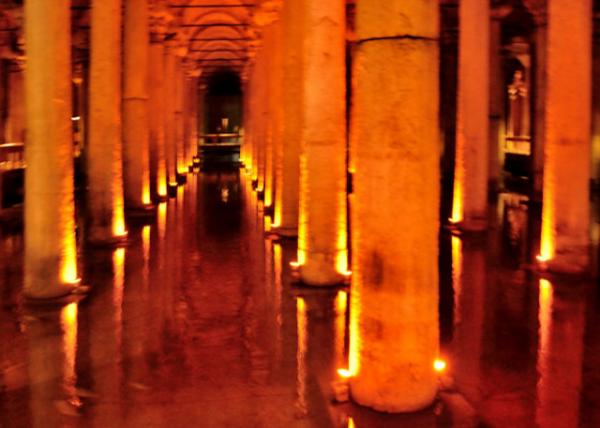 A Forest of 336 Marble Columns (336根大理石圆柱) A Forest of 336 Marble Columns (336根大理石圆柱)
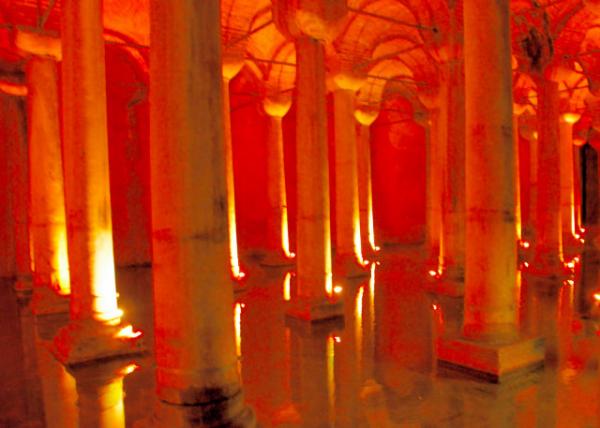 Capitals of the Columns Mainly in Ionic & Corinthian Styles Capitals of the Columns Mainly in Ionic & Corinthian Styles
(柱头主要采纳爱奥尼亚与科林斯“巔峰之地”风格) 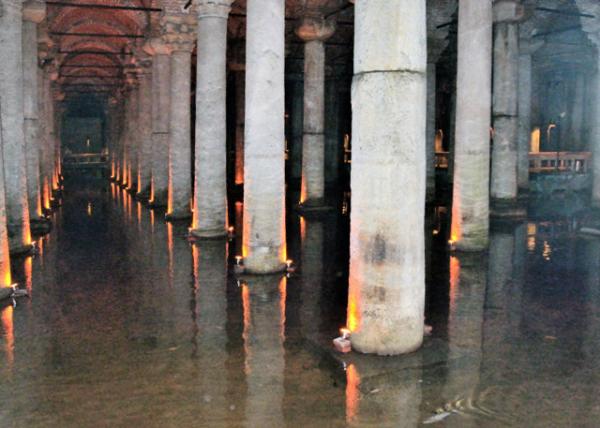 The Column Capitals Mainly in Ionic and Corinthian Styles The Column Capitals Mainly in Ionic and Corinthian Styles
(柱头主要采纳爱奥尼亚与科林斯风格) 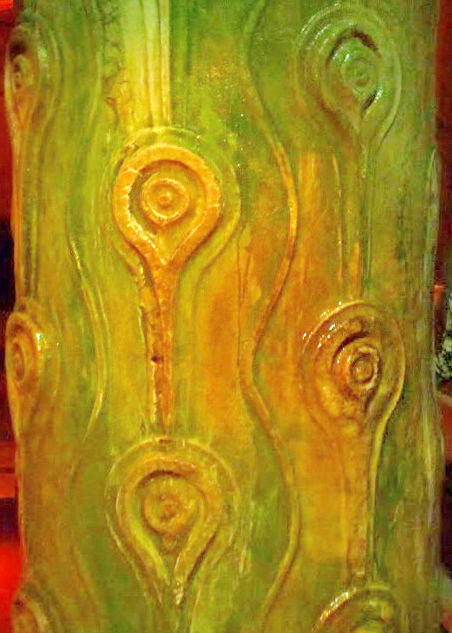
Peacock-Eyed Column w/ Tears (流眼泪的孔雀眼圆柱) 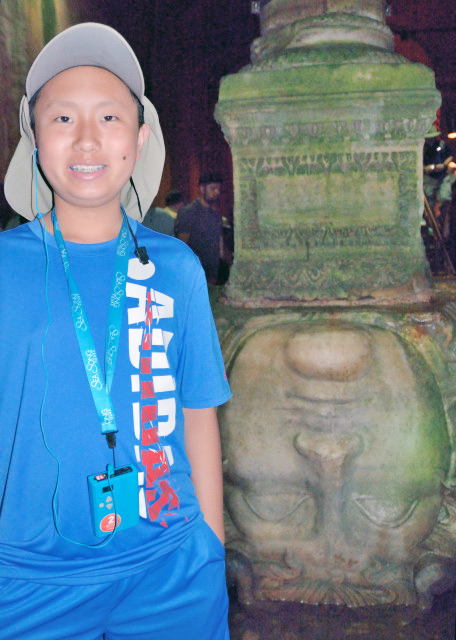
Medusa Head Pillar (蛇发女怪美杜莎脑袋倒立的石柱底座 06-27-2015) 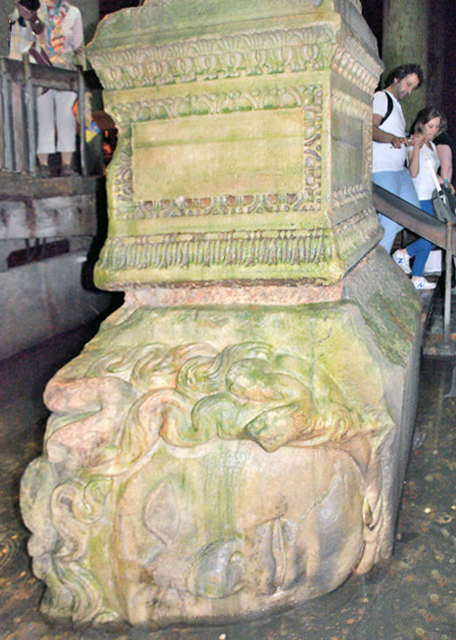
Medusa Sideway Pillar (蛇发女妖脑袋侧立的石柱底座)
 Lunch @ Matbah Restaurant (追风餐馆·午餐 06-27-2015) Lunch @ Matbah Restaurant (追风餐馆·午餐 06-27-2015)

午餐:橄榄油煸四季豆与羊奶酪茄子鹰嘴豆泥、小牛肉砂锅菜、覆盆子酱拌布丁 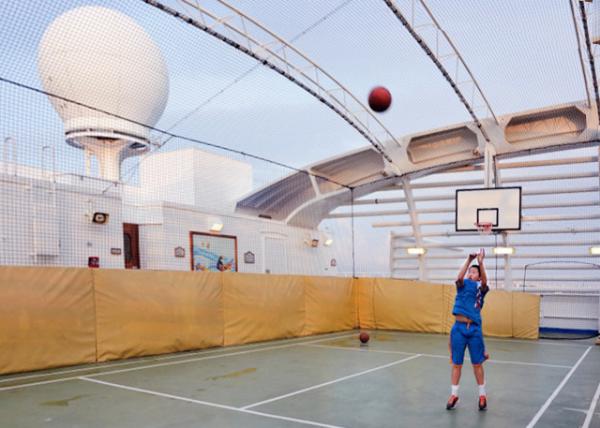 Sports Deck @ Emerald Princess Sports Deck @ Emerald Princess
(“公主·翡翠”号游轮——运动甲板) Crosslinks(相关博文): Turkey(出游土耳其)
Europe(欧洲掠影) 6th Grade(初中一年级) |
